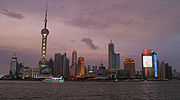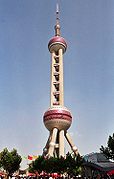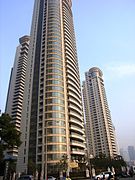- Pudong
-
Pudong New Area
浦东新区— Sub-Provincial District — Pudong skyline at night Location within Shanghai Country  People's Republic of China
People's Republic of ChinaMunicipality Shanghai District Gov't Established 1993 Government – CPC Pudong District Secretary Xu Lin (徐麟) – District Governor Li Yiping (李逸平) Area – Total 1,210.4 km2 (467.3 sq mi) Population (2010)[1] – Total 5,044,430 – Density 4,167.6/km2 (10,794/sq mi) Time zone China Standard Time (UTC+8) Area Code 021 Postal Code 200135 Website pudong.gov.cn Pudong New Area Simplified Chinese 浦东新区 Traditional Chinese 浦東新區 Wu phu上ton平 sin平 chiu平 Transcriptions Mandarin - Hanyu Pinyin Pǔdōng Xīn Qū Wu - Romanization phu上ton平 sin平 chiu平 Pudong (Chinese: 浦东; pinyin: Pǔdōng, lit "Huangpu East Bank") is an area of Shanghai, China, located along the east side of the Huangpu River, across from the historic city center of Shanghai in Puxi. Formerly a little-developed agricultural area linked only by ferries, Pudong has grown rapidly since the 1990s and emerged as China's financial and commercial hub. It is principally administered as the Pudong New Area, a district of Shanghai.
Pudong is home to the Lujiazui Finance and Trade Zone and the Shanghai Stock Exchange and many of Shanghai's best-known buildings, such as the Oriental Pearl Tower, the Jin Mao Building, the Shanghai World Financial Center. It is also the site of the future Shanghai Tower. These modern skyscrapers face directly across from Puxi's historic Bund, the remnant of Shanghai's former concessions.
Contents
History
Pudong refers to the land in the east of Huangpu River. Originally, the area was mainly farmland and countryside with some warehouses and wharfs near the shore. The parts closest to Puxi were administered by its districts, including Huangpu, Yangpu, and the former Nanshi District. The rest of the area was administered by Chuansha County.
In 1993, the Chinese government decided to set up a Special Economic Zone in Chuansha, creating the Pudong New Area. The western tip of the Pudong district was designated as the Lujiazui Finance and Trade Zone and proposed to become the new financial hub of modern China. Several landmark buildings were constructed in Lujiazui to raise the image and awareness of the area. These include the Oriental Pearl Tower, the Jin Mao Building, and the supertall Shanghai World Financial Center. At 494 m, the last will be the tallest building in China until the completion of the nearby Shanghai Tower, projected to reach 565.6 m in 2014.
On May 6, 2009, it was disclosed that the State Council had approved the proposal to merge Nanhui District to Pudong. the Pudong New Area comprises the majority of land in eastern Shanghai.
Government
Districts of the direct-controlled municipality of Shanghai are administratively on the same level as prefecture-level cities. However, the government of Pudong has a status equivalent to that of a sub-provincial city, which is a half-level above a prefecture-level city. This is due to Pudong's size and importance as the financial hub of China.
Geography
Pudong literally means "East Bank". Pudong is bounded by the Huangpu River in the west and the East China Sea in the east. It has an area of 1210.4 km² and a population of more than 5 million people. Pudong is distinguished from Puxi ("West Bank"), the older part of Shanghai, which is divided into several administrative districts.
Population
Since its inception as a special economic zone and China's financial centre, Pudong's population of 5 million largely consists of migrants from the Puxi side of Shanghai and those from other regions in China.
Economy
With the Nanhui District merger in May 2009, Pudong's new gross domestic product amounts to an estimated 370 billion RMB (US$53.98 billion), roughly equal to that of Slovenia. Its GDP per capita is therefore around US$16,938. The area's aggregate GDP has now surpassed that of six provincial-level entities.
The area is divided into four distinct economic districts. Apart from Lujiazui Trade and Finance Zone, there is Waigaoqiao Free Trade Zone, the largest free trade zone in mainland China covering approximately 10 km² in north-east Pudong. The Jinqiao Export Processing Zone is another major industrial area in Pudong covering 19 km². Zhangjiang Hi-tech Park is a special area for technology-oriented businesses, covering 17 km² in central Pudong.[citation needed]
The Pudong area continues to experience rapid development, especially in the commercial sector, with 1.3 million square meters of prime office space reaching completion in 2008, more than the previous two years combined.[2]
Pudong has also attracted considerable fixed asset and real estate investment, reporting 87.268 billion RMB in fixed asset investment and 27.997 billion RMB in real estate investment in 2008.[3]
The newest Disney Theme Park is now under construction in Pudong. It is planned to be operational by 2013.[4]
Hang Seng Bank has its mainland offices in the Hang Seng Bank Tower in Pudong.[5] Kroll has an office in the Hang Seng Bank Tower.[6]
Transportation
The Shanghai Pudong International Airport opened its doors in 1999, shortening the travel time for visitors.
In the same year, Line 2 of the Shanghai Metro commenced services. An extension brought the line further east, where it serves the airport. Other lines, namely Lines 4, 6, 7, 8, 9, 12 and 13 also have sections that serve parts of Pudong. A magnetic levitation train began operating in 2004, moving passengers between the airport and Longyang Road Metro station.
Pudong is connected to Puxi by several tunnels and four major bridges. The first of these bridges were the Nanpu Bridge (1991) and the Yangpu Bridge (1993). The Xupu Bridge opened in 1996. The latest of these is Lupu Bridge, which is the world's second longest arch bridge and was completed in 2002. Currently there are five tunnels that link the two sides, Dapu Rd. Tunnel, the first tunnel across the Huangpu River, Yan'an Rd. Tunnel, running east-west, and Dalian Rd. Tunnel, running north-south, Fuxing Rd. Tunnel, complementing the Yan'an Rd. Tunnel, Waihuan Tunnel, one part of Shanghai Outer Ring Express. Two new tunnels linking Lujiazui to Puxi are under construction.
Roads in Pudong have no particular longitudinal or latitudinal orientation. Major thoroughfares Pudong Avenue, Zhangyang Road and Yanggao Road run east-west until Yangpu Bridge before turning gradually to become north-south. Century Avenue crosses all three major roads and extends from Lujiazui to Century Park. Yanggao Road extends south to the A20, Shanghai's outer Ring road, which runs east-west from Xupu Bridge and then north-south beginning at the interchange near Renxi Village, when the east-west expressway turns into Yingbin Avenue, headed for Pudong International Airport.
Gallery
-
Pudong at night (video)
-
View of Pudong area, using HDR technique
-
View of the Oriental Pearl Tower
See also
- Binhai New Area(Tianjin)
- Beijing CBD
- Central, Hong Kong
- Nishi-shinjuku (Tokyo)
- Bankenviertel (Frankfurt am Main)
- La Defense (Paris)
- City of London (London)
- Manhattan (New York)
- Singapore CBD
- Financial District (Toronto)
- Chicago Loop
References
- ^ Chinese Shanghai 2010 Census Data Eastday
- ^ Knight Frank China Knight Frank China, Shanghai Commercial Market Quarterly Report, Q4 2009
- ^ Knight Frank China Knight Frank China, Shanghai Commercial Market Quarterly Report, Q1 2009
- ^ "[1]." THE WALT DISNEY COMPANY REACHES ANOTHER MAJOR MILESTONE ON SHANGHAI THEME PARK PROJECT. Retrieved on July 7, 2010.
- ^ "Mainland Service Network." Hang Seng Bank. Retrieved on 11 September 2011. "Hang Seng Bank(China)Limited Address: 34/F & 36/F, Hang Seng Bank Tower, 1000 Lujiazui Ring Road, Pudong, Shanghai, China"
- ^ "Office locations." Kroll Inc. Retrieved on 14 August 2011. "Shanghai Room 3031, 30F 1000 Lujiazui Ring Road, Hang Seng Bank Tower Pudong New Area Shanghai 200120 China"
External links
Articles related to Pudong Municipality of Shanghai Administrative divisions County Areas Culture and demographics Attractions Jinjiang Action Park • Nanjing Road • Shanghai Concert Hall • Shanghai Grand Theatre • Shanghai New International Expo Center • Shanghai Zoo • Yuyuan GardenMuseums Parks Places of Worship ChristianOtherSports venues Towers Transport Hongqiao International Airport • Pudong International Airport • Shanghai Metro • Shanghai Public Transportation Card • Maglev Train • Shanghai Railway Station • Shanghai South Railway Station • Hongqiao Railway Station • Trams in Shanghai • Zhangjiang Tram • Shanghai Bus • Trolleybuses in ShanghaiUniversities Major hotels Metropolitan cities of the People's Republic of China Municipalities and National central cities Regional central cities Special administrative regions Sub-provincial cities (not included above) Separate state-planning cities (not included above) Provincial capitals (not included above) Autonomous regional capitals Comparatively large cities (not included above) Special economic zone cities (not included above) Coastal development cities (not included above) XPCC / Bingtuan cities State-level new areas Pudong New Area (Shanghai) · Binhai New Area (Tianjin) · Liangjiang New Area (Chongqing) · Zhoushan Archipelago New Area (Zhoushan)Economic Development Zones of the People's Republic of China The original four Special Economic Zones New open development zones Hainan Province · Dalian · Qingdao · Qinhuangdao · Lianyungang · Pudong · Yantai · Zhanjiang · Ningbo · Wenzhou · Nantong · Fuzhou · Guangzhou · BeihaiNew Areas of the People's Republic of China State-level New Areas Pudong New Area* (Shanghai) · Binhai New Area* (Tianjin) · Liangjiang New Area (Chongqing) · Zhoushan Archipelago New Area (Zhoushan)City-level New Areas Shenbei New Area* (Shenyang) · New North Zone (Chongqing) · Zhengdong New Area (Zhengzhou) · Zhengbian New Area (Zhengzhou) · Hunnan New Area (Shenyang) · Xixian New Area (Xi'an / Xianyang) · Qujiang New Area (Xi'an) · Zhenjiang New Area (Zhenjiang) · Wuxi New Area (Wuxi) · Hangzhou Bay New Area (Ningbo) · Honggutan New Area (Nanchang) · Jinyang New Area (Guiyang) · Jinshan New Area (Fuzhou) · Guangming New Area (Shenzhen) · Pingshan New Area (Shenzhen) · Hengqin New Area (Zhuhai) · Jinzhou New Area (Dalian) · Pulandian Bay New Area (Dalian) · Luoyang New Area (Luoyang) · Kangbashi New Area (Ordos)Planned New Areas Note: with "*" are part of the People's Republic of China Ministry of Civil Affairs in the Administrative divisions of the People's Republic of China. While other New Areas are established as economic management areas.Coordinates: 31°14′05″N 121°30′23″E / 31.23472°N 121.50639°E
Categories:- Districts of Shanghai
- Special Economic Zones
- Central business districts
Wikimedia Foundation. 2010.


















